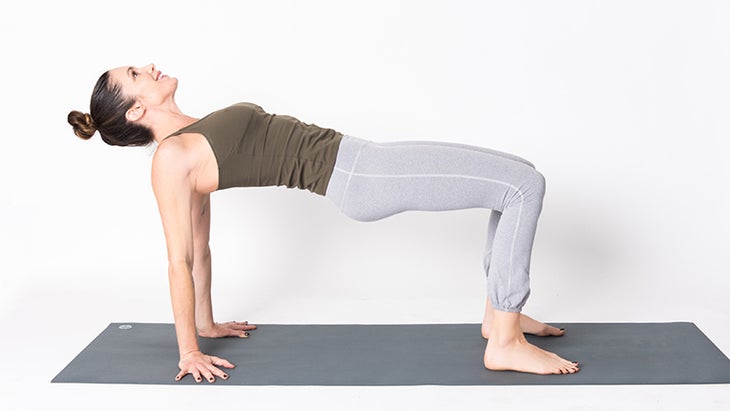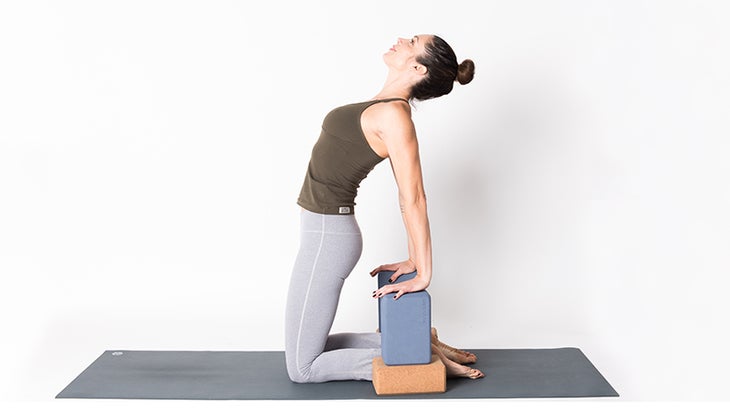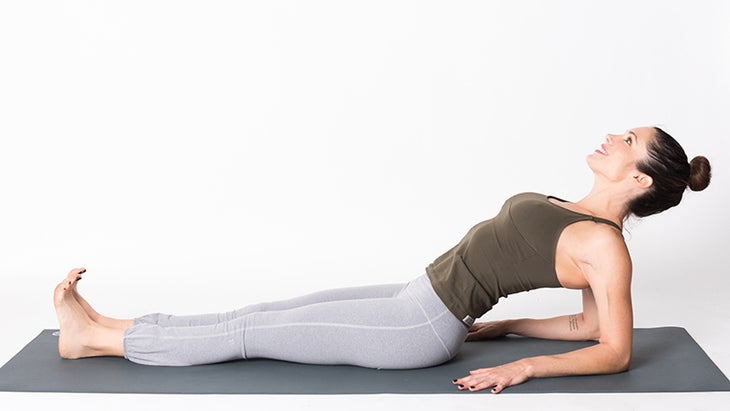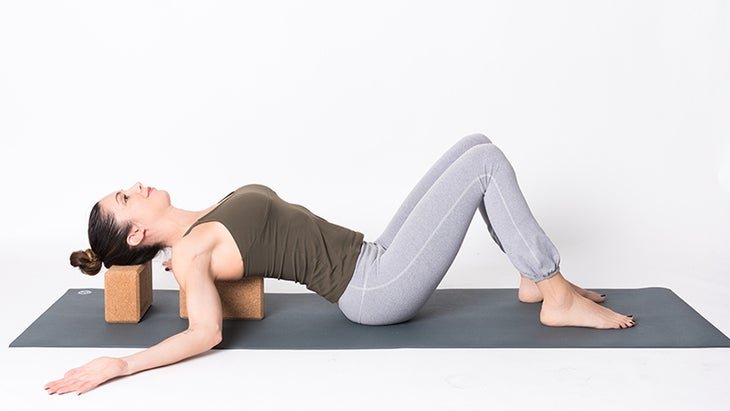“], “filter”: { “nextExceptions”: “img, blockquote, div”, “nextContainsExceptions”: “img, blockquote, a.btn, a.o-button”} }”>
Backbending while pregnant can bring a range of sensations from most delicious to most painful. These poses will open you up only where you need it most and reduce risk of injury.
If pregnant women practice backbends as they did pre-pregnancy, they’re likely in for more pain than gain. We can see how by looking at the shape of the spine of a pregnant woman: Typically she will have exaggerated lordosis of the lumbar spine (overarching of the lower back) and increased kyphosis of the thoracic spine (rounding forward of the upper back). Both are due to the weight of the growing and stretching belly. Muscularly, in an effort to support the baby, her chest muscles tighten (causing the upper back and shoulders to round forward) while the abdominals get overstretched. Later in pregnancy, the abs are just barely holding on and the low back muscles contract to compensate.
When we consider this shape, we can easily see that the only part of the spine that needs to backbend is the upper back. Deepening the arch in the lumbar spine further stretches the already overstretched abdominals, putting mamas at risk for developing diastasis recti (the tearing away of the rectus abdominis from the fibrous tissue that connects them, called the linea alba) and pubic symphysis dysfunction (inflammation and pain of the pubic bone). Deep backbends can also lead to sacroiliac joint imbalances, which can lead to sciatica (already a common complaint among pregnant women). With the hormone relaxin present in the body during pregnancy, all of the ligaments of the pelvis are loose. If a backbend isn’t performed perfectly symmetrically, one side of the pelvis easily slips up at the SI joint causing low back pain and potentially sciatica. By practicing backbends that target only the thoracic spine, we get the delicious sensation of opening only where we really need it.
6 Backbends Perfect for Pregnancy
Supported Backbend
Every mama will love the gentle opening of the upper back and chest this well-supported position facilitates.
Place one block between the shoulder blades to lift the chest and another at the same height to support the head. With the knees bent and the feet flat on the mat, let the arms open out to the sides in a position that allows the shoulder heads to drop toward the mat.
See also Prenatal Yoga: The Secret to Preventing Postnatal Saggy Butt
Sphinx Pose on Blocks and Bolster

During pregnancy, the femurs shift forward in the hip sockets. Using the bolster therapeutically beneath the top of the thigh helps lift the femurs toward the hamstrings, centering the thighbone more in the hip socket. It also gives extra height, creating space for the baby bump.
With the tops of the thighs resting on the bolster, place the blocks beneath the shoulders. Bring the forearms to the blocks. The elbows are beneath or slightly in front of the shoulders. Press the forearms into the blocks and (without moving them in space) drag them back toward your hips so you can pull the chest through the gateway of your arms and lift the heart to the sky, opening the upper back.
See alsoThe Benefits of Prenatal Yoga
Upward-Facing Dog Pose (Urdhva Mukha Svanasana)

Press into the hands, widen across the collarbones, and lift the chest through the arms. With the bolster supporting the tops of the thighs, we minimize the downward pull of gravity and the overstretching of the abdominals.
See alsoQ+A: Grace Flowers on Pregnancy + Living Wholeheartedly
Purvottanasana (Upward Plank) Prep

The forward pull on the body during pregnancy makes it difficult to place the shoulder blades well on the back body. The placement of the arms in this posture makes it easier to position the shoulder blades to support the lifting and opening of the chest. While the chest stretches, the hamstrings engage to lift the hips creating strength in the backs of the legs while simultaneously opening and stretching the fronts of the legs.
Place the hands beneath the shoulders fingers facing you with arms in a slight external rotation. Bend the knees, plant the feet hip-distance apart with all 10 toes facing forward, traction the heels toward your bum and lift the hips. Press the hands to straighten the arms, spread the collarbones and feel the shoulder blades lifting and opening the chest to the sky.
See also Prenatal Yoga: A Pelvic Floor Sequence for an Easier Labor + Delivery
Camel Pose (Ustrasana) with Blocks

I like to use four blocks in this variation. The extra height really allows me to press my hands down to get that delicious heart-opening upper backbend, without backbending in the places that don’t need it.
Come to standing on the shins with the knees beneath the hips. Place the blocks toward your ankles and to the outsides of the shins with one in its lowest position and a second on top in the highest. Press the shins into the earth and feel the inner thighs roll back toward your big toes. Try to keep the hips over the knees while bringing your hands to the blocks with the fingertips facing you. Press the hands down to lift the heart to the sky. The head can drop back or not, it is personal preference.
See also The Guide to Prenatal Yoga: Everything You Need To Know
Venice Beach Pose

Named by my teacher Annie Carpenter, this is my all-time favorite upper-back opener while pregnant! It’s an amazing way to get the upper back bending to open the chest with no risk of overstretching the abdominals.
Come to seated with the legs extended straight out in front of you. Lean back propping yourself up on your forearms as if you were lying on the beach and watching the water. Bring the big toes together and the heels slightly apart. As the top thighs get heavy and fall to the earth, press the forearms down, stretch across the chest and lift the heart to the sky.
See alsoTools for Teaching Prenatal Yoga: The Third Trimester
About our expert

Los Angeles-based yoga teacher Karly Treacy began her practice more than 20 years ago. A student of Annie Carpenter, Karly understands the awareness of body and strength that comes from precise alignment. A mother of three, Karly credits yoga for teaching her that all of life is a practice, especially motherhood and that our children, our bodies, and our environment all are our teachers.
Follow her on:
karlytreacy.com/
Twitter: karlytreacyyoga
Facebook: karly.treacy

